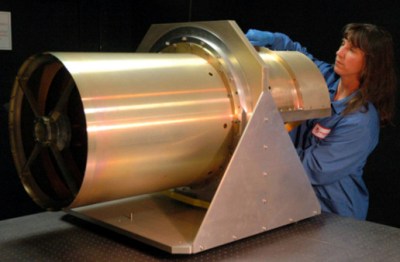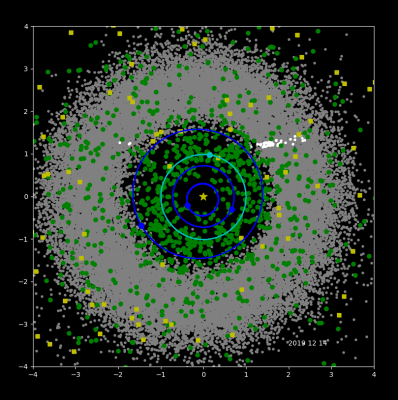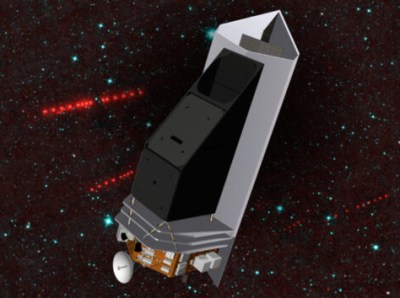Over the last few weeks the media has been full of talk about NEOWISE, one of the brightest and most spectacular comets to ever pass through our solar system that you can still see if you hurry. While the excitement over this interstellar traveler is more than justified, it’s also an excellent opportunity to celebrate the Wide-field Infrared Survey Explorer (WISE) space telescope it was named after. The discovery of this particular comet is just the latest triumph in the orbiting observatory’s incredible mission of discovery that’s spanned over a decade, with no signs of slowing down anytime soon.
In fact, WISE has been operational for so long now that its mission has evolved beyond its original scope. When it was launched in December 2009 from California’s Vandenberg Air Force Base, its primary mission was scheduled to be completed in less than a year. But like many NASA spacecraft that came before it, WISE achieved its original design goals and found itself ready for a new challenge. Though not before it spent almost three years in hibernation mode as the agency decided what to do with it.
The Sky, One Picture at a Time
The primary mission for WISE was to image the entire sky as it appears from Earth in multiple wavelengths of the infrared band. Orbiting at an altitude of approximately 500 kilometers and taking care to always point its telescope away from the planet’s surface and the Moon, WISE would take a picture every 11 seconds. Eventually the orbiting observatory had collected millions of images, with each section of the sky being photographed at least eight times so they could be “stacked” to increase accuracy.

The images were captured using a 40 cm (16 inch) diameter telescope and four separate infrared detectors operating at 3.4, 4.6, 12 and 22 microns respectively. To maximize sensitivity, the entire optical assembly was mounted inside a cryostat on the spacecraft and cooled to approximately 17 Kelvin by a block of solid hydrogen. As long as the telescope and detectors could be kept at this temperature, WISE boasted a sensitivity thousands of times greater than previous IR observing spacecraft.
By October 2010, after nine months of observations, the last of the solid hydrogen had sublimed and the telescope temperature started to rise. At this point, WISE had completed a full survey of the sky and was about halfway through its second pass. While the telescope could still operate at a higher temperature, the data it collected could no longer be directly compared to that of the mission’s “cold” phase; as such, WISE’s primary mission was brought to a close.
Experimental Extension
Of course, WISE running out of coolant didn’t come as a surprise. Mission planners knew from the start that they were in a race against the clock and that the second sky survey probably wouldn’t finish in time, but they decided to try and get as much useful science as possible out of the telescope in its ideal configuration. Once the telescope could no longer be actively cooled, it was just a matter of finding a suitable task for the spacecraft’s reduced capabilities.
NASA’s Planetary Division proposed a new mission they called Near-Earth Object WISE (NEOWISE). WISE had already discovered thousands of asteroids during its initial full sky survey, and it was believed that even with the telescope’s reduced sensitivity, performing another scan could help identify potentially dangerous nearby objects. The experiment continued for four months, enough time to complete another full scan of the sky. After all of the data had been downloaded, the spacecraft was commanded to turn off its transmitter and go into hibernation mode on February 1st, 2011.
Planetary Defense
The story might have ended there. Even if WISE was never powered back up, the mission would have been a phenomenal success. But almost two years to the day that the spacecraft was put into hibernation mode, an asteroid entered the Earth’s atmosphere and exploded over Chelyabinsk, Russia.

Releasing roughly 30 times the energy as the atomic bomb dropped on Hiroshima, the event was a sobering reminder of the danger posed by even relatively small asteroids. Under pressure to come up with ways to detect and ideally deflect similar objects in the future, NASA decided to restart the successful NEOWISE program.
After establishing communication with the satellite in September of 2013, ground controllers commanded the craft to point the telescope towards deep space to start radiating away its accumulated heat. After a month this brought the telescope down to 75 Kelvin, and the IR detectors were recalibrated as best as possible.
It’s not a perfect solution, as the increased operating temperature and limitations in the telescope’s software mean that NEOWISE has trouble identifying objects smaller than 100 meters in diameter. Even so, the observatory has been able to identify hundreds of nearby asteroids since its reactivation; nearly 50 of which have been classified as potentially hazardous.
A Weary Guardian
The Wide-field Infrared Survey Explorer continues to operate under the NEOWISE program to this day. On March 27 it discovered the comet that would eventually bear its name, a testament to the observatory’s continuing scientific value a decade after its primary mission came to a close. Now on its 14th complete scan of the sky since its reactivation in 2013, NEOWISE has made nearly a million infrared measurements of more than 37,000 objects in our solar system.

Even considering how successful this post-hibernation program has been, the fact remains that the observatory’s hardware is past its prime and is being used for a task it was never intended for. History will look back on programs like NEOWISE and Kepler’s K2 as some of the most brilliant mission extensions ever devised, but they shouldn’t be considered replacements for launching new missions.
The Near-Earth Object Camera (NEOCam) telescope is specifically designed to take over for WISE as a dedicated observatory for detecting and categorizing asteroids and comets in our solar system, with the ultimate goal of finding ways to deflect or neutralize objects found to be on a collision course with the planet.
Unfortunately securing funding for the mission has been difficult, and the project has had several false starts. So until it can be relieved of duty by NEOcam or a similar spacecraft, WISE will remain at its post, doing its best to give us an early warning should any cosmic travelers head our way.
















Sadly, NEOWISE won’t be able to remain at its post very much longer. As described above, its coolant is long gone and it depends on radiating to space to keep it still cool enough for half of its sensors to do still something useful. Unfortunately, orbital precession due to upper atmosphere drag is slowly moving it so that it so won’t be able to avoid its cool parts getting hit by reflected light from Earth and heating it, degrading the data.
We’ve been lucky and it has survived this long only because the unusually low solar minimum has kept the atmosphere density low at that altitude, and the precession has been slow. The solar minimum is ending though, and it’s already running on borrowed time.
A heck of a run though.
I remember the news about it’s “cool fuel” running out and it’s being mothballed. I didn’t know about the wake up call that Chelyabinsk did to it.
Arthur C. Clark’s novel Rendezvous With Rama has an impact giving earth a wake up call on a future date of infamy, 9-11.
Shame they didn’t add a powered cooler that could kick in after the H2 was used up.
They’re pretty smart folks. I’m sure they would not have chosen to launch 210 liters of solid hydrogen if they had the option to use a cryocooler.
How big a cryocooler, solar panel and radiator would be required to supply the cooling needed?
That was outside the budget.
ReLaunch a shuttle. Minimum crew. Cargo bay it down. Refuel. Maybe add an altitude booster or vent the warmed hydrogen out a micro-thruster port, and add a re-cool-fueling port for in-space refills during other missions… and a sun umbrella.
It’s sad that this kind of mission is (currently) not possible as no other vehicle had that unique feature set of the shuttle.
On the other hand, reality has shown it’s almost always better/cheaper to just build a new spacecraft and launch. Especially with how cheap you can put a payload into orbit these days.
Send up Bruce Willis to kick start that sucker